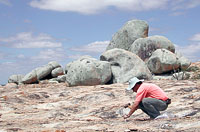
"4000 atoms counted so far this quarter"*
In this course you will learn how to predict the build-up of cosmic-ray-produced nuclides in the Earth’s outermost surface. We start with the basic framework of exposure dating — after the first few weeks you will be able to calculate the age of static rock surfaces from cosmogenic nuclide data. Next we develop the theory of cosmogenic nuclide build-up underground. This allows us to predict nuclide concentrations at and beneath surfaces that are changing in time, through processes such as erosion and burial.
The basic idea of the course is that every "geomorphic model" {x, y, z(t)} makes a prediction about cosmogenic isotope concentrations {x, y, N(z,t)}. Thus we should be able to test geomorphic models by making cosmogenic isotope measurements. Having learned to predict nuclide concentrations at and beneath geomorphic surfaces, you will be able to decide which geomorphic parameters can be estimated from cosmogenic nuclide data, how many samples you will need to make useful estimates, and how and where to sample to get the most information from the fewest measurements. And more.

